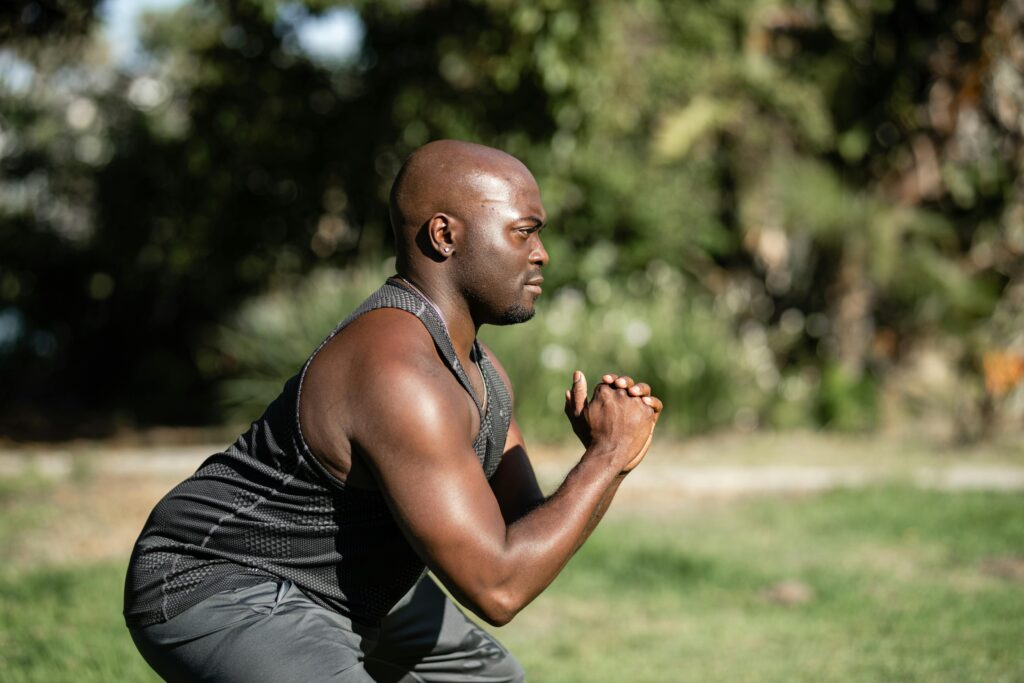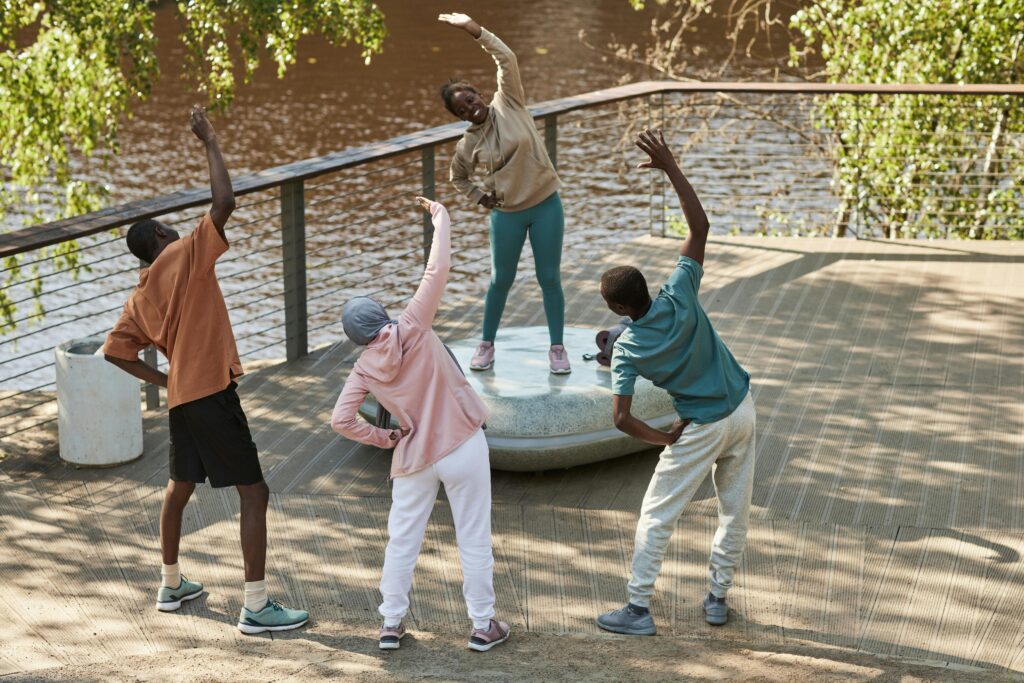
Beginner Fitness Guide:
An 8-Week Workout Plan for Sustainable Results
With an emphasis on laying a strong foundation, the 8-week beginner training plan is an organized program created to introduce people to fitness. With a focus on correct form and progressive growth, it usually combines strength training with cardio. Two to three strength training days per week are usually included in the plan, with active recovery or rest days in between. Cardio exercises like jogging, brisk walking, or cycling may also be a part of it.
Best Workout for Beginners
ACSM research proves that beginners using a gradual progression workout plan achieve 72% better long-term adherence by prioritizing proper form for beginners over heavy lifting. This science-backed training program ensures:
+ No injuries
– Teaches correct movement before adding weight.
+ Steady progress
– Uses a competency-based approach (move up only when ready).
+ Avoids burnout
– Balances workouts with recovery.
The 8-Week Beginner Training Plan: Beginner Workout Schedule
Phase 1: Weeks 1-4 (Mastering the Basics) (Beginner Exercises)
Bodyweight squats (3×10 reps) are the ultimate no-equipment leg workout, proven to tone legs, boost endurance, and burn fat. This beginner-friendly exercise targets your quadriceps, glutes, hamstrings, and core while improving mobility and balance. For perfect form:
-
Keep feet shoulder-width apart
-
Lower until the thighs are parallel
-
Drive through heels to activate explosive power
Add [3 sets of 10 reps] to your home workout or HIIT routine for lean muscle growth—no gym needed!
In order to develop upper-body muscle with less wrist strain, beginners and expert lifters should master incline push-ups (3×6-8 reps). Raise your hands on a step or bench to increase activation but decrease difficulty in your shoulders, triceps, and chest. Ideal for:
(i) Progressive strength training
(ii) Plans for hypertrophy
(iii) Home workouts without equipment
For toned arms and a stronger core, perform 3 sets of 6-8 reps without the use of weights!
The best isometric core training to develop unbreakable strength, improve posture, and increase full-body stability is the [2-minute plank challenge. This [no-equipment workout] teaches [mind-muscle connection] and works your [abs, obliques, lower back, and shoulders]. Planks are ideal for people of all fitness levels since they:
(i) Prevent back pain
(ii) Improve sports performance
(iii) Constrict your abdomen
Novice?
Start with holds of 20–30 seconds and work your way up to 2 minutes per day. To prevent sagging, keep your hips level, your elbows beneath your shoulders, and your core supported. Without going to the gym, incorporate this isometric powerhouse into your ab circuit or morning routine for noticeable improvements in a matter of weeks!
Expert Tip: According to ACSM, new lifters should prioritize form over weight to prevent injuries and ensure muscle activation.
Phase 2: Weeks 5-8 (Beginner Strength Training)
Master goblet squats (3×8 reps) to build powerful quadriceps, sculpt lean glutes, and strengthen your core while perfecting your squat form. This beginner-friendly kettlebell exercise develops functional lower body strength and teaches proper squat mechanics—the foundation for safe weightlifting progression. For optimal results:
• Keep your chest upright and core engaged
• Lower until thighs are parallel to the floor.
• Drive through heels to activate glutes
Add this essential compound movement to your leg day routine or full-body workout for noticeable muscle growth in weeks.
For safe strength progression, follow this science-backed set/rep system:
-
Do 3-5 sets per exercise, stopping 1-2 reps before failure
-
Rest 30-60 seconds between sets to maintain performance
-
Gradually increase from 10 reps/set to 25 reps/set over 4-6 weeks
-
Complete 8-10 total sets per muscle group weekly
Beginner? Start with:
-
Bodyweight exercises (push-ups, squats)
-
Resistance bands ($10-$20 on Amazon)
-
Light dumbbells (5-15 lbs)
Pro Tip: 12-15 minute daily sessions build better consistency than 1-hour weekly marathons. Commercial gyms offer the best equipment, but home workouts work too!
Dumbbell rows (3×8 reps per arm) build back thickness and correct muscle imbalances. This unilateral exercise targets lats, rhomboids, and biceps while improving posture. Keep elbows at 45°, core braced, and pull to hip level. Ideal for home gyms or strength programs.
Progression Rule: Only increase weight when you can do 3 sets with perfect form.
Fitness Tips for Beginners
1.0 Focus on Form First
– Poor technique leads to injuries and slows progress.
2.0 Start Light, Progress Slowly
– Add 5-10% more weight only when comfortable.
3.0 Rest & Recovery
– Muscles grow during rest, not workouts (aim for 48 hours between sessions).
Diet for Beginner Gym-Goers
Eat Enough Protein (0.7-1g per pound of body weight) to support muscle repair.
Stay Hydrated – Dehydration reduces performance and recovery.
Sleep 7-9 Hours – Essential for muscle growth and energy.
Workout Mistakes for Beginners
1.0 Skipping Warm-Ups
Increases injury risk (spend 5-10 mins on dynamic stretches).
2.0 Comparing Yourself to Others
Progress at your own pace.
3.0 Ignoring Mobility Work
Tight muscles limit movement quality
Final Thoughts
This beginner-friendly fitness plan removes the guesswork and sets you up for long-term success. Stick with it for 8 weeks, track your progress, and you’ll build a strong foundation for more advanced training.

Frequently Asked Questions
1. What is the best 8-week workout plan for beginners?
Our 8-week beginner fitness guide combines strength training, cardio, and flexibility routines to help you build a strong foundation. It’s designed for sustainable results without burnout.
2. Can beginners see results in 8 weeks?
Yes, with consistency and a proper workout plan, beginners can see noticeable improvements in strength, energy levels, and body composition within 8 weeks.
3. Do I need a gym membership for this 8-week workout plan?
No. This plan includes home workout options using bodyweight, resistance bands, or light dumbbells — ideal for those without gym access.
4. How many days a week should a beginner work out?
The guide recommends working out 4–5 days a week, with at least 2 rest or active recovery days for optimal recovery and growth.


